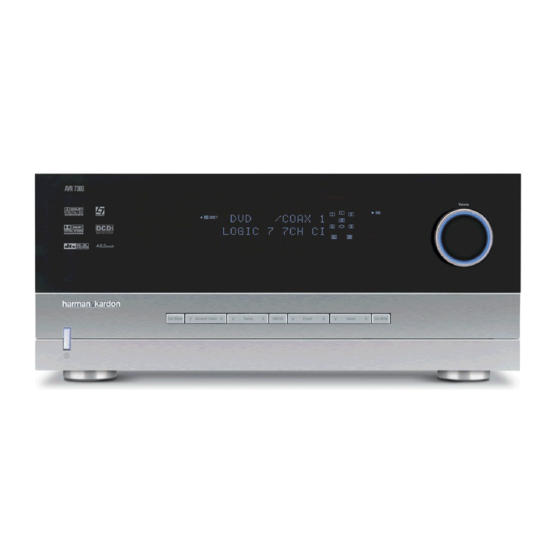
Harman Kardon AVR 7300 Test Report
Digital surround receiver
Hide thumbs
Also See for AVR 7300:
- Service manual (158 pages) ,
- Owner's manual (62 pages) ,
- Quick start manual (4 pages)
Advertisement
Quick Links
TEST REPORT
Harman Kardon
AVR 7300 Digital Surround Receiver
A
t first glance, Harman Kardon's
AVR 7300, the latest flagship
receiver from the venerable
American brand, looks little
different from its predecessors.
And in a lot of ways, it is the
same. After all, big power, extensive sig-
nal-routing, powerful setup flexibility, and
an attractively restrained, black-and-silver
aesthetic were hallmarks of several previ-
ous Harman Kardon flagships, and the AVR
7300 has them, too. But a bit of digging
quickly revealed some significant changes.
First, the AVR 7300 piles on Dolby Pro
Logic IIx (DPL IIx), Dolby's latest, 6.1/7.1-
channel version of its surround processing
for two- and four-channel sources. (DPL IIx
derives back surround channels from both
Dolby Surround-encoded and plain stereo
sources, with impressive results.) Second,
the receiver incorporates not just ample vid-
eo switching (including three component-
video inputs), but video processing as well
by an onboard Faroudja DCDi engine. Oth-
erwise, the AVR 7300 is everything I'd ex-
pect in a flagship receiver, and that's a lot.
62 NOVEMBER 2004 SOUND & VISION
DANIEL KUMIN
The "key features" list on the fac-
SETUP
ing page hits the high spots, but a few de-
mand more attention, like EZSet, which
uses a test microphone in the remote con-
trol to balance channel levels automatical-
ly. It worked smoothly, with very accurate
results, as long as the receiver and the re-
mote were more or less in line — the remote
needs to "see" the receiver to communicate
via infrared throughout the process.
More valuable in my book was the re-
ceiver's unusually complete configurability.
You can set the crossover frequency inde-
pendently for each speaker or channel pair,
with seven choices between 40 and 200 Hz
— and you can dial in a different set of fre-
quencies for each input, too. (In fact, you
must do so, or at least copy your setup for
each input you'll use. It's a bit of a chore at
setup time, but you only need to do it once.)
Most other options can also be set individ-
ually for each input, including surround
mode, tone settings, and channel levels.
But the AVR 7300's most newsworthy
feature — Faroudja DCDi video processing
— is also among its subtlest. The headline
here is the ability to "upscale" 480i (inter-
laced) video, like standard-definition broad-
cast TV, to 480p (progressive-scan) format,
like the output of a progressive-scan DVD
player. All of my video sources — my uni-
versal DVD player, my TiVo/DVD recorder,
and my Comcast high-def cable box — can
do the same already, and this is likely to
be the case in a lot of up-to-date systems.
But the AVR 7300 lets you assign video-
setup modes individually for each input —
not only DCDi deinterlacing but also set-
tings for video noise reduction, brightness,
contrast, saturation, display format (4:3 or
16:9), and so on.
fast facts
RATED POWER
110 W x 7 into 8 ohms
with maximum 0.05% THD (channels driven
individually)
(WxHxD) 17
⁄
DIMENSIONS
3
8
20
1
⁄
inches
2
WEIGHT
55 pounds
$2,399
PRICE
MANUFACTURER
Harman Kardon,
harmankardon.com, 516-255-4545
x 7
⁄
x
5
8
Advertisement

Summary of Contents for Harman Kardon AVR 7300
- Page 1 Harman Kardon flagships, and the AVR 7300 has them, too. But a bit of digging quickly revealed some significant changes. First, the AVR 7300 piles on Dolby Pro Logic IIx (DPL IIx), Dolby’s latest, 6.1/7.1- channel version of its surround processing for two- and four-channel sources.
- Page 2 Debussy and Ravel string quartets sounded more lifelike with DPL IIx. The good news is that the AVR 7300 lets you select one or the other at the touch of a button. The slim, silvery remote con- OPERATION SOUND &...
- Page 3 20 Hz to 20 kHz +0, –0.3 dB MULTICHANNEL PERFORMANCE, ANALOG INPUT Distortion (THD+N, 1 kHz, 8 ohms)...0.01/0.03% The AVR 7300 performed exceptionally well in the lab. Power output was unusually strong, especially with five and seven channels driven. Crossover response was generally consistent, but the 12-dB-per-octave low-pass subwoofer output was a little unusual —...





